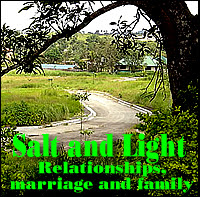Our subject deals with one of the tragic realities of life – spousal abuse. My previous article “Hope and help for the battered woman: Statistics on domestic violence” paints a very grim picture of spousal abuse as a worldwide phenomenon. The article on the “Battered Woman Syndrome” (BWS) is taken from the Supreme Court decision in the case of Marivic Genosa, a Leyteña convicted of murdering her husband for which the trial court imposed on her the death penalty. On automatic appeal of Genosa’s case to the High Court, nationally-known lawyer Katrina Legarda introduced BWS as Genosa’s defense. The Court decided the case several months before the passage of Republic Act 9262 or the “Anti-Violence Against Women and Their Children Act of 2004” into law in March 2004.
As you can read from my Legal Updates article, the Court took BWS into consideration but said that (1) the presence of the syndrome was not proven in Genosa’s case; and ()] the Court’s hands were tied by the prevailing provisions of the Revised Penal Code which did not consider BWS as a justifying circumstance that would enable Genosa to claim valid self-defense.
Nevertheless, the Supreme Court considered two mitigating circumstances in Genosa’s favor, reduced her penalty, and for time already served, ordered Genosa’s release from the Correctional Institution for Women in Mandaluyong.
The Supreme Court’s decision is quite a read, even for law students, but if you’re a counselor, pastor, or someone who personally knows a battered woman, you should take the time and effort in understanding it.
"Battered Woman Syndrome" defined and as a defense in criminal cases
Please take note that Republic Act 9262 or the “Anti-Violence Against Women and their Children Act of 2004” became law after the Genosa decision. RA 9262 defines BWS as “a scientifically defined pattern of psychological and behavioral symptoms found in women living in battering relationships as a result of cumulative abuse.”
Section 26 of RA 9262 discusses the “Battered Woman Syndrome” as a defense, to wit,
Victim-survivors who are found by the courts to be suffering from battered woman syndrome do not incur any criminal and civil liability notwithstanding the absence of any of the elements for justifying circumstances of self-defense under the Revised Penal Code.In layman’s terms, now, under RA 9262, if an abused woman kills or inflict physical injuries on her abusive husband or live-in partner, once the trial court determines that she is suffering from the “Battered Woman Syndrome,” the court will declare her not guilty. (As I mentioned above, the Court stated that BWS was not proven in Genosa’s case and that the provisions of the Revised Penal Code on the elements of justifying circumstances on self-defense thus had to be followed.)
In the determination of the state of mind of the woman who was suffering from battered woman syndrome at the time of the commission of the crime, the courts shall be assisted by expert psychiatrists/ psychologists.
Characteristics of a battered woman
During the re-hearing at the Leyte trial court, expert witnesses Dra. Natividad Dayan and Dr. Pajarillo testified on what the Battered Woman Syndrome was. The Supreme Court decision states in detail what BWS is. For the sake of clarity, I have numbered the paragraphs of this portion of the Court’s decision.
1. In claiming self-defense, Genosa raises the novel theory of the battered woman syndrome. While new in Philippine jurisprudence, the concept has been recognized in foreign jurisdictions as a form of self-defense or, at the least, incomplete self-defense. By appreciating evidence that a victim or defendant is afflicted with the syndrome, foreign courts convey their “understanding of the justifiably fearful state of mind of a person who has been cyclically abused and controlled over a period of time.”Effects of battering
2. A battered woman has been defined as a woman “who is repeatedly subjected to any forceful physical or psychological behavior by a man in order to coerce her to do something he wants her to do without concern for her rights. Battered women include wives or women in any form of intimate relationship with men. Furthermore, in order to be classified as a battered woman, the couple must go through the battering cycle at least twice. Any woman may find herself in an abusive relationship with a man once. If it occurs a second time, and she remains in the situation, she is defined as a battered woman.”
3. Battered women exhibit common personality traits, such as low self-esteem, traditional beliefs about the home, the family and the female sex role; emotional dependence upon the dominant male; the tendency to accept responsibility for the batterer’s actions; and false hopes that the relationship will improve.
4. More graphically, the battered woman syndrome is characterized by the so-called “cycle of violence,” which has three phases: (1) the tension-building phase; (2) the acute battering incident; and (3) the tranquil, loving (or, at least, nonviolent) phase.
5. During the tension-building phase, minor battering occurs - it could be verbal or slight physical abuse or another form of hostile behavior. The woman usually tries to pacify the batterer through a show of kind, nurturing behavior; or by simply staying out of his way. What actually happens is that she allows herself to be abused in ways that, to her, are comparatively minor. All she wants is to prevent the escalation of the violence exhibited by the batterer. This wish, however, proves to be double-edged, because her “placatory” and passive behavior legitimizes his belief that he has the right to abuse her in the first place.
6. However, the techniques adopted by the woman in her effort to placate him are not usually successful, and the verbal and/or physical abuse worsens. Each partner senses the imminent loss of control and the growing tension and despair. Exhausted from the persistent stress, the battered woman soon withdraws emotionally. But the more she becomes emotionally unavailable, the more the batterer becomes angry, oppressive and abusive. Often, at some unpredictable point, the violence “spirals out of control” and leads to an acute battering incident.
7. The acute battering incident is said to be characterized by brutality, destructiveness and, sometimes, death. The battered woman deems this incident as unpredictable, yet also inevitable. During this phase, she has no control; only the batterer may put an end to the violence. Its nature can be as unpredictable as the time of its explosion, and so are his reasons for ending it. The battered woman usually realizes that she cannot reason with him, and that resistance would only exacerbate her condition.
8. At this stage, she has a sense of detachment from the attack and the terrible pain, although she may later clearly remember every detail. Her apparent passivity in the face of acute violence may be rationalized thus: the batterer is almost always much stronger physically, and she knows from her past painful experience that it is futile to fight back. Acute battering incidents are often very savage and out of control, such that innocent bystanders or intervenors are likely to get hurt.
9. The final phase of the cycle of violence begins when the acute battering incident ends. During this tranquil period, the couple experience profound relief. On the one hand, the batterer may show a tender and nurturing behavior towards his partner. He knows that he has been viciously cruel and tries to make up for it, begging for her forgiveness and promising never to beat her again. On the other hand, the battered woman also tries to convince herself that the battery will never happen again; that her partner will change for the better; and that this “good, gentle and caring man” is the real person whom she loves.
10. A battered woman usually believes that she is the sole anchor of the emotional stability of the batterer. Sensing his isolation and despair, she feels responsible for his well-being. The truth, though, is that the chances of his reforming, or seeking or receiving professional help, are very slim, especially if she remains with him. Generally, only after she leaves him does he seek professional help as a way of getting her back. Yet, it is in this phase of remorseful reconciliation that she is most thoroughly tormented psychologically.
11. The illusion of absolute interdependency is well-entrenched in a battered woman’s psyche. In this phase, she and her batterer are indeed emotionally dependent on each other -- she for his nurturant behavior, he for her forgiveness. Underneath this miserable cycle of “tension, violence and forgiveness,” each partner may believe that it is better to die than to be separated. Neither one may really feel independent, capable of functioning without the other.
The Supreme Court, based on the testimonies of the expert witnesses presented in Genosa’s defense, summarized the effects when a woman is abused over a period of time. Again, for the sake of clarity, I have numbered the paragraphs of this particular portion of the Court’s decision.
1. Because of the recurring cycles of violence experienced by the abused woman, her state of mind metamorphoses. In determining her state of mind, we cannot rely merely on the judgment of an ordinary, reasonable person who is evaluating the events immediately surrounding the incident. A Canadian court has aptly pointed out that expert evidence on the psychological effect of battering on wives and common law partners are both relevant and necessary. “How can the mental state of the appellant be appreciated without it? The average member of the public may ask: Why would a woman put up with this kind of treatment? Why should she continue to live with such a man? How could she love a partner who beat her to the point of requiring hospitalization? We would expect the woman to pack her bags and go. Where is her self-respect? Why does she not cut loose and make a new life for herself? Such is the reaction of the average person confronted with the so-called ‘battered wife syndrome.’”As I pointed out in the introductory portion of this article, the Supreme Court decided the Genosa case several months before RA 9262 was promulgated. Now RA 9262, specifically Section 26, expressly provides for the “Battered Woman Syndrome” as a defense, even in the absence of any of the elements for justifying circumstances of self-defense under the Revised Penal Code.
2. To understand the syndrome properly, however, one’s viewpoint should not be drawn from that of an ordinary, reasonable person. What goes on in the mind of a person who has been subjected to repeated, severe beatings may not be consistent with -- nay, comprehensible to -- those who have not been through a similar experience. Expert opinion is essential to clarify and refute common myths and misconceptions about battered women.
3. The theory of BWS formulated by Lenore Walker, as well as her research on domestic violence, has had a significant impact in the United States and the United Kingdom on the treatment and prosecution of cases, in which a battered woman is charged with the killing of her violent partner. The psychologist explains that the cyclical nature of the violence inflicted upon the battered woman immobilizes the latter’s “ability to act decisively in her own interests, making her feel trapped in the relationship with no means of escape.” In her years of research, Dr. Walker found that “the abuse often escalates at the point of separation and battered women are in greater danger of dying then.”
4.Corroborating these research findings, Dra. Dayan said that “the battered woman usually has a very low opinion of herself. She has self-defeating and self-sacrificing characteristics.” When the violence would happen, they usually think that they provoked it, that they were the ones who precipitated the violence; that they provoked their spouse to be physically, verbally and even sexually abusive to them.”
Spousal abuse: In the name of submission?
In the area of relationships and marriage, there cannot be a more explosive and divisive issue than that of the headship of men and the submission of women. Sometime in the late 1990’s, I think, the Southern Baptist Convention issued an official statement asking women to “graciously submit” to their husbands. Needless to say, that statement was greeted with controversy, scorn and ridicule from different sectors and even from within the Convention itself. Feminist groups have been saying all these time that the Biblical injunction for women to submit to their husbands is an open invitation for spousal abuse.
If you want a thorough discussion of the Biblical doctrines of the headship of men and the submission of women, I recommend the following books to you:
1. “Strike the Original Match” by Chuck Swindoll; Multnomah Press © 1980; specifically the chapters entitled “Let’s Repair the Foundation” and “Bricks that Build a Marriage.”In a previous article entitled “The Myth of Mutual Submission part 2” , I wrote about the true story of Lucy Tisland who, like Marivic Genosa, killed her husband after enduring years of abuse. The question is, “How should individual Christians, pastors and churches respond to the issue of spousal abuse?”
2. “The Grace Awakening” also by Chuck Swindoll; Word Publishing, ©1996; specifically the chapter entitled “A Marriage Oiled by Grace”
3. “Together Forever” by Anne Kristin Caroll; Zondervan, © 1982 by Barbara J. Denis); specifically the chapter entitled “Who Wears the Pants?”
4. “Rocking the Roles” by Robert Lewis and William Hendricks; NavPress, ©1991; specifically the chapters entitled “The ‘S’ Word” and “The Masculine Counterpart to the ‘S’ Word.”
I have discussed this issue in my article entitled “Hope and help for the battered woman (5): Biblical response to spousal abuse” but let me re-state here some of the main points of that article:
1. Spousal abuse is a sin, and as such, must be dealt with in keeping with Matthew 18, in situations where the spouses concerned are members of the church.
2. Spousal abuse is not only a sin, but also a crime punishable under RA 9262. Since Romans 13 commands us to be subject to the higher powers, pastors and church counselors cannot close their eyes, send the abused woman back into the abusive situation, and simply hope for the best. God’s miracle and protection for the abused woman have already been provided for in laws such as RA 9262. Pastors and counselors should therefore be familiar with the provisions of this law in order to ably counsel abused women on their rights.







